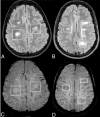Value of 3T Susceptibility-Weighted Imaging in the Diagnosis of Multiple Sclerosis
- PMID: 32439639
- PMCID: PMC7342768
- DOI: 10.3174/ajnr.A6547
Value of 3T Susceptibility-Weighted Imaging in the Diagnosis of Multiple Sclerosis
Abstract
Background and purpose: Previous studies have suggested that the central vein sign and iron rims are specific features of MS lesions. Using 3T SWI, we aimed to compare the frequency of lesions with central veins and iron rims in patients with clinically isolated syndrome and MS-mimicking disorders and test their diagnostic value in predicting conversion from clinically isolated syndrome to MS.
Materials and methods: For each patient, we calculated the number of brain lesions with central veins and iron rims. We then identified a simple rule involving an absolute number of lesions with central veins and iron rims to predict conversion from clinically isolated syndrome to MS. Additionally, we tested the diagnostic performance of central veins and iron rims when combined with evidence of dissemination in space.
Results: We included 112 patients with clinically isolated syndrome and 35 patients with MS-mimicking conditions. At follow-up, 94 patients with clinically isolated syndrome developed MS according to the 2017 McDonald criteria. Patients with clinically isolated syndrome had a median of 2 central veins (range, 0-19), while the non-MS group had a median of 1 central vein (range, 0-6). Fifty-six percent of patients who developed MS had ≥1 iron rim, and none of the patients without MS had iron rims. The sensitivity and specificity of finding ≥3 central veins and/or ≥1 iron rim were 70% and 86%, respectively. In combination with evidence of dissemination in space, the 2 imaging markers had higher specificity than dissemination in space and positive findings of oligoclonal bands currently used to support the diagnosis of MS.
Conclusions: A single 3T SWI scan offers valuable diagnostic information, which has the potential to prevent MS misdiagnosis.
© 2020 by American Journal of Neuroradiology.
Figures





References
Publication types
MeSH terms
LinkOut - more resources
Full Text Sources
Medical
